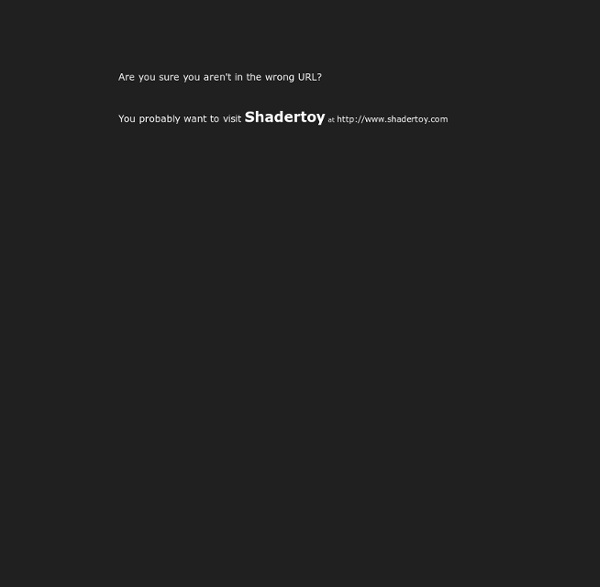



WebGL Inspector An advanced WebGL debugging toolkit About WebGL Inspector is a tool inspired by gDEBugger and PIX with the goal of making the development of advanced WebGL applications easier. What Firebug and Developer Tools are to HTML/JS, WebGL Inspector is to WebGL. Note: this is alpha software - if you find bugs, let me know (or better yet, fork and fix them! Check out the readme on github for more information. Status There hasn't been an update in awhile, but the project is not dead! Features Extension for injecting into pages Embed in an existing application with a single script include Capture entire GL frames Annotated call log with stepping/resource navigation and redundant call warnings Pixel history - see all draw calls that contributed to a pixel + blending information GL state display Resource browsers for textures, buffers, and programs Live Demo Click here to view a live demo (in a browser that supports WebGL, of course): Install ATTENTION: The extension is now hosted on the Chrome Web Store.
Artsology Click and drag your mouse on the canvas to create different colored rectangular shapes and create a geometric abstract "painting." Each time you make a new geometric shape, a random color combination will appear, so no two paintings will ever be the same. Experiment with different designs, whether you overlap them or keep them separate. If you come up with something you really like, take a screen shot and send it to us and we'll start a geometric art gallery. If you want some inspiration, scroll down below the canvas and check out some geometric art paintings from famous artists. Clear your canvas and start a new painting Here's a few examples of geometric abstract art painted by famous artists:
GLSL 1.2 Tutorial In this tutorial shader programming using GLSL 1.2 will be covered. Although many parts are now considered deprecated, the essence of GLSL has remained constant. Besides, this tutorial will continue to be online because learning the basics of deprecated OpenGL is easier than learning the new versions. If you’re looking for a GLSL tutorial that deals only with non-deprecated features visit the GLSL Core tutorial, here in Lighthouse3D. Shaders are a hot topic and 3D games have shown that they can be put to good use to get remarkable effects. The tutorial contains an introduction to the specification, but reading the OpenGL 2.0 and GLSL official specs is always recommended if you get serious about this. GLSL stands for GL Shading Language, often referred as glslang, and was defined by the Architectural Review Board of OpenGL, the governing body of OpenGL. I won’t go into disputes, or comparisons, with Cg, Nvidia’s proposal for a shading language that is also compatible with OpenGL. Index
Dreamlines Dreamlines was an interactive net-art work created in 2005. It lived a long (in Internet-era time, anyway) and happy life, but it is no longer functional: the technologies it was based on became obsolete, especially the Java browser plugin. It could be recreated with current web technologies, but until I get round to doing that, I decided to take it down to avoid frustration for visitors who might still come here. While you can’t have the first-hand experience at the moment, you can look at some documentation to get an idea of what was it like. The original description of the work Some screen captures on Flickr Video captures of different search strings on Vimeo: plum, raspberry, vacation A more documentary video uploaded by Tomás Rawski that shows the user interaction with the work You can also download the original source code [ZIP] (beware, it was made with Processing 1.0 and it is not going to run without significant updates).
uncontrol | A collection of experiments using fancy shmancy code ToonDoo - World's fastest way to create cartoons! Free 3D Models, Free CAD Models 5 Top Sites To Download Free Kids Music That You’ll Love If you’ve got kids, you’ve no doubt thought about how you might be able to increase the size of their music collection for free. I mean, who wants to listen to the same CD of nursery rhymes over and over again, right? So in order to keep your sanity while your kids listen to their favourite songs, the best trick is to have more of them – and the higher quality you can manage to find the better. Thankfully, the Internet is full of free music and fun things for kids. Remember: DownThemAll When checking out these sites and other sites of free music, don’t forget that there are tools like DownThemAll and Wget which make it really easy to download all of the MP3s in one hit. Jamendo Kids Music Check out the Jamendo Child/Kids/Children tags (and perhaps the Jamendo Enfants tag) to browse hundreds of free albums for kids. Free Kids Music The Free Kids Music site asks for user submissions of free music and writes a short spiel on each artist it promotes. Nancy Stewart Music Dream English
Host your 3D printer projects. Version control included.